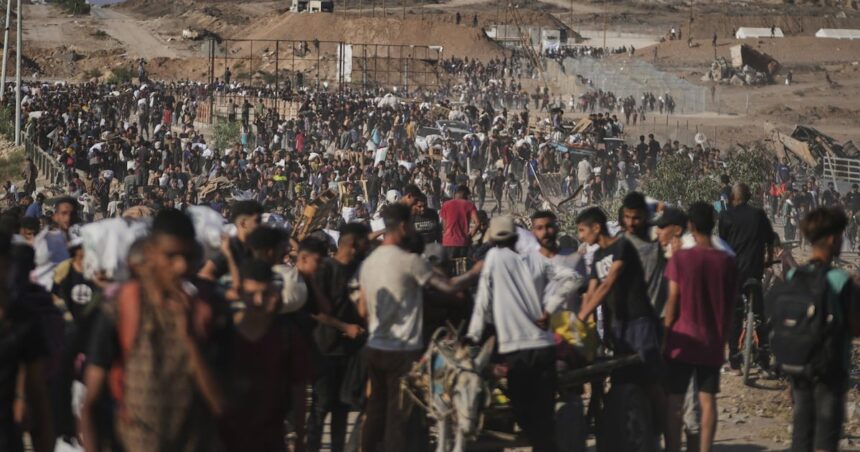In Gaza’s northern Jabalia district yesterday, where aid deliveries remain critically scarce, Fatima Zarqawi described watching fellow Palestinians risk death for food. “People are desperate—they run toward the trucks knowing soldiers might shoot,” she told me via a secure messaging app. “My neighbor’s son was hit in the leg last week trying to get flour.”
This harrowing reality sits at the center of explosive allegations that Israeli Prime Minister Benjamin Netanyahu vehemently denied Monday, calling reports that Israeli soldiers have standing orders to fire at Palestinians attempting to access humanitarian aid “false and outrageous.”
The controversy erupted after Israeli news outlet +972 Magazine published claims from military whistleblowers that Israel Defense Forces (IDF) commanders had authorized troops to shoot at Palestinians approaching aid convoys, allegedly considering all people in certain areas as legitimate targets regardless of whether they posed a threat.
“These are fabrications. The IDF does not shoot at those coming for humanitarian aid,” Netanyahu declared in a video statement. His office further characterized the allegations as “a blood libel that endangers the security of our soldiers.”
The IDF spokesperson’s unit similarly rejected the accusations, insisting that their rules of engagement strictly prohibit firing at civilians who don’t present imminent danger. They emphasized that protocols require soldiers to distinguish between civilians and militants, especially around aid distribution points.
The clash over these allegations unfolds against a devastating humanitarian backdrop. The UN Office for the Coordination of Humanitarian Affairs reported last week that approximately 1.1 million people in Gaza—nearly half the population—face “catastrophic” levels of food insecurity. Several aid workers from international organizations have documented chaotic scenes at distribution points, where thousands of desperate civilians converge on limited supplies.
“What we’re seeing is a complete breakdown of orderly distribution,” explains Sarah Levin from the International Rescue Committee, who recently returned from the Gaza periphery. “When trucks arrive, it becomes a survival situation, not an aid operation.”
The humanitarian crisis has worsened dramatically since Israel’s military response to Hamas’s October 7 attack, which killed approximately 1,200 Israelis and saw about 250 taken hostage. The subsequent bombing and ground operations in Gaza have resulted in over 34,500 Palestinian deaths, according to the Hamas-run health ministry, figures that don’t distinguish between civilians and combatants.
While visiting the Kerem Shalom crossing last month, I witnessed firsthand the bottlenecks hampering aid delivery. Trucks backed up for kilometers, with drivers describing waits of 72 hours or more for security clearance. Israeli officials maintain these inspections are necessary to prevent weapons smuggling, while humanitarian organizations argue the process has become unnecessarily restrictive.
Defense Minister Yoav Gallant addressed the aid controversy Monday, stating that Israel has “significantly increased” humanitarian access to Gaza in recent weeks. Data from COGAT, the Israeli military body overseeing civilian affairs in Palestinian territories, indicates approximately 500 aid trucks entered Gaza last week—though this remains well below the pre-war average of 500 trucks daily.
The shooting allegations draw increased scrutiny to incidents like the February 29 tragedy, when at least 118 Palestinians were killed around an aid convoy in Gaza City. While Palestinian officials described it as deliberate fire on civilians seeking food, Israeli authorities claimed their forces responded to threatening crowds and that most casualties resulted from stampeding and crushing.
European Union foreign policy chief Josep Borrell called for an independent investigation into those events, stating that “starvation as a weapon of war is prohibited under international humanitarian law.”
For Palestinians like Mohammed Abed, a father of four currently sheltering in Deir al-Balah, the debate over shooting policies feels academic amid daily survival challenges. “We spend hours lining up for water, for bread, for anything,” he told me during a phone interview. “Whether they have orders to shoot or not, people die trying to feed their families. This is our reality.”
The controversy comes as pressure mounts on Netanyahu from multiple directions. Domestically, families of hostages still held by Hamas have intensified protests demanding prioritization of a deal to secure their release. Internationally, the International Criminal Court prosecutor has requested arrest warrants for both Hamas leaders and Israeli officials, including Netanyahu himself, for alleged war crimes.
As negotiations for a ceasefire and hostage release agreement continue in Cairo, the allegations regarding aid access add another layer of complexity to Israel’s military operations in Gaza—operations that Israeli officials insist are targeting Hamas infrastructure while critics increasingly question their humanitarian toll.
Standing beside a half-empty aid warehouse in central Gaza last month, UNRWA spokesperson Adnan Abu Hasna offered a perspective that transcends the political disputes: “When you see children fighting over bread crumbs, the question isn’t just about who’s responsible—it’s about how quickly we can end this suffering.”






